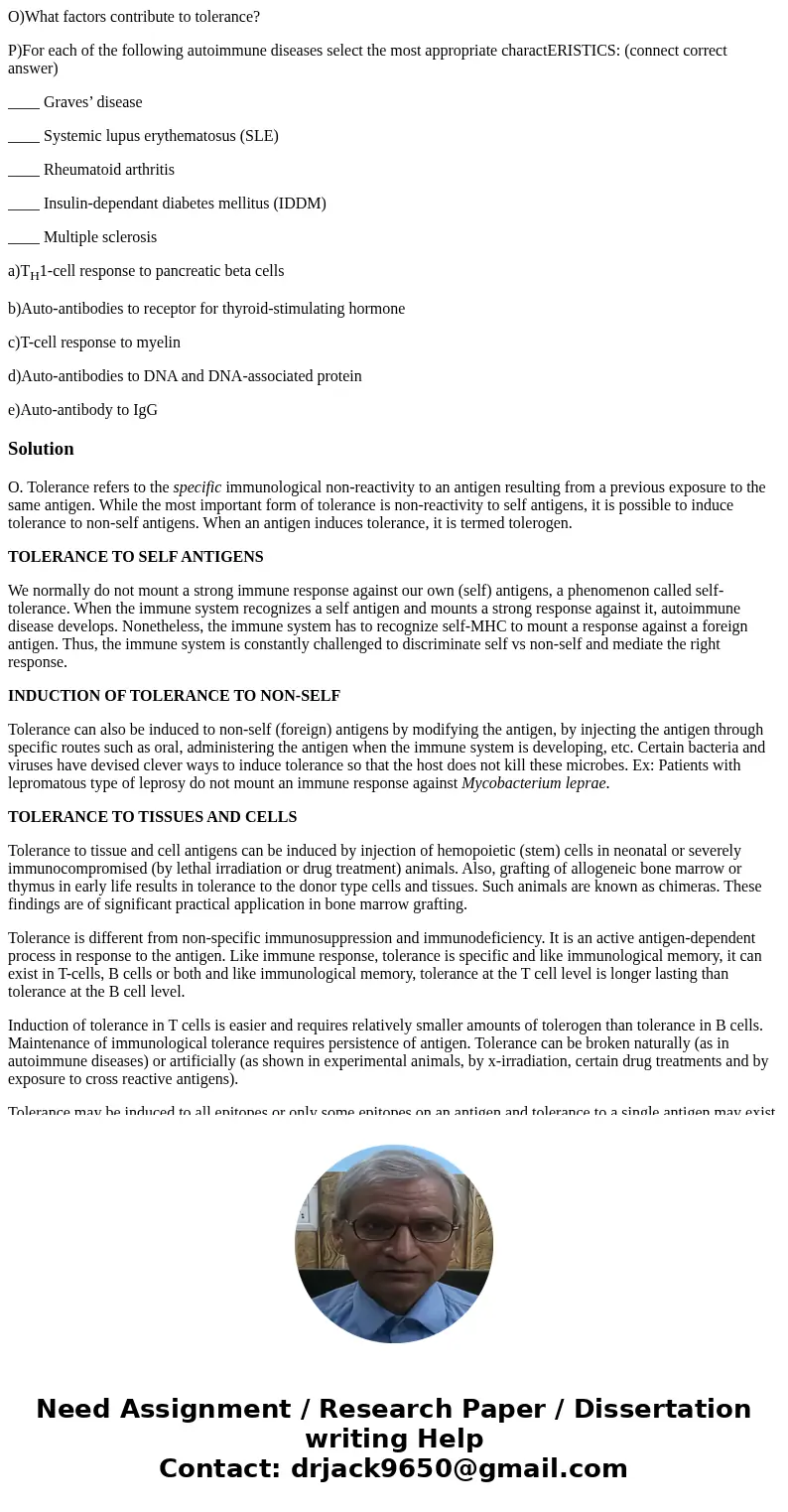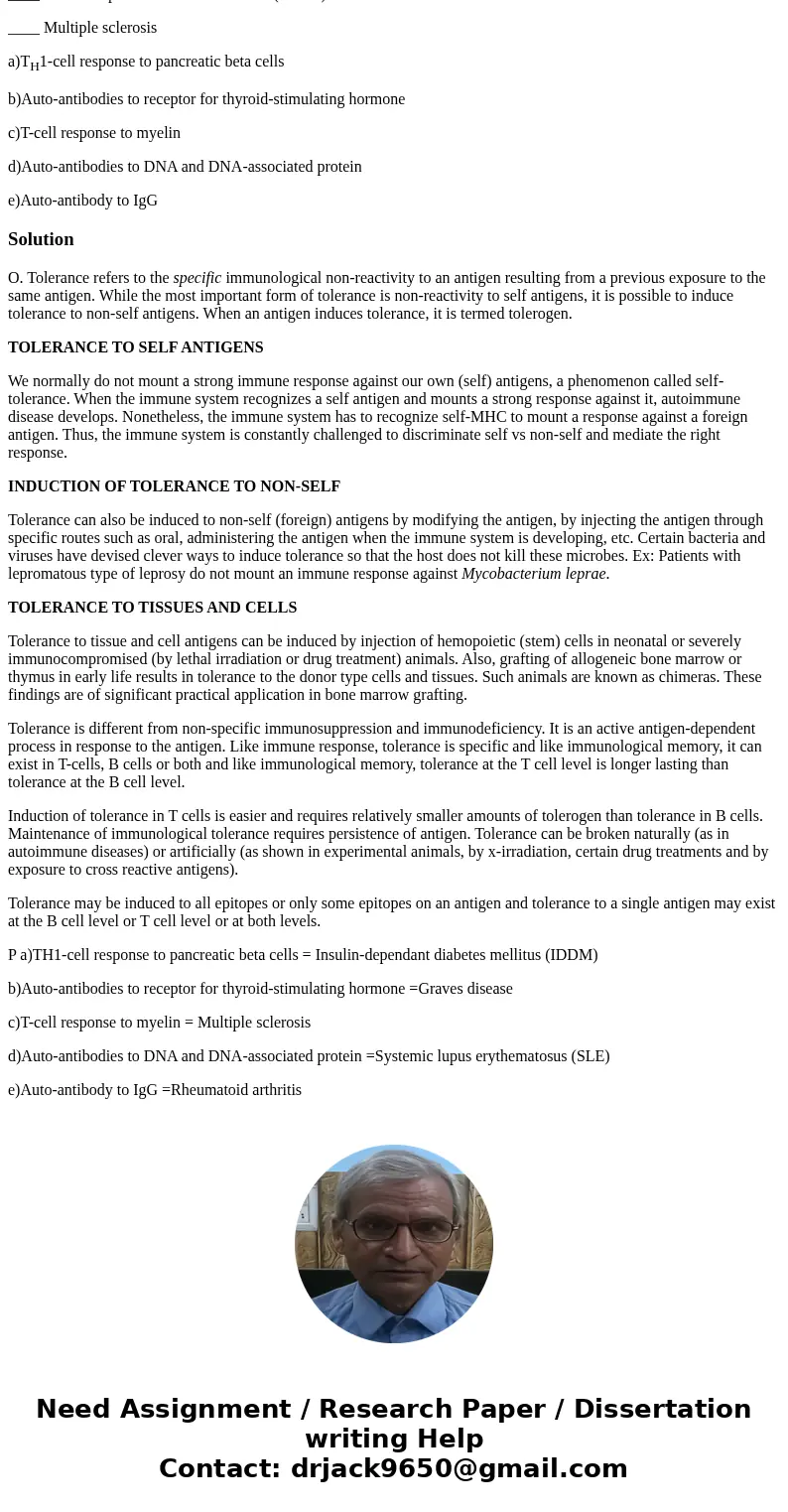OWhat factors contribute to tolerance PFor each of the follo
O)What factors contribute to tolerance?
P)For each of the following autoimmune diseases select the most appropriate charactERISTICS: (connect correct answer)
____ Graves’ disease
____ Systemic lupus erythematosus (SLE)
____ Rheumatoid arthritis
____ Insulin-dependant diabetes mellitus (IDDM)
____ Multiple sclerosis
a)TH1-cell response to pancreatic beta cells
b)Auto-antibodies to receptor for thyroid-stimulating hormone
c)T-cell response to myelin
d)Auto-antibodies to DNA and DNA-associated protein
e)Auto-antibody to IgG
Solution
O. Tolerance refers to the specific immunological non-reactivity to an antigen resulting from a previous exposure to the same antigen. While the most important form of tolerance is non-reactivity to self antigens, it is possible to induce tolerance to non-self antigens. When an antigen induces tolerance, it is termed tolerogen.
TOLERANCE TO SELF ANTIGENS
We normally do not mount a strong immune response against our own (self) antigens, a phenomenon called self-tolerance. When the immune system recognizes a self antigen and mounts a strong response against it, autoimmune disease develops. Nonetheless, the immune system has to recognize self-MHC to mount a response against a foreign antigen. Thus, the immune system is constantly challenged to discriminate self vs non-self and mediate the right response.
INDUCTION OF TOLERANCE TO NON-SELF
Tolerance can also be induced to non-self (foreign) antigens by modifying the antigen, by injecting the antigen through specific routes such as oral, administering the antigen when the immune system is developing, etc. Certain bacteria and viruses have devised clever ways to induce tolerance so that the host does not kill these microbes. Ex: Patients with lepromatous type of leprosy do not mount an immune response against Mycobacterium leprae.
TOLERANCE TO TISSUES AND CELLS
Tolerance to tissue and cell antigens can be induced by injection of hemopoietic (stem) cells in neonatal or severely immunocompromised (by lethal irradiation or drug treatment) animals. Also, grafting of allogeneic bone marrow or thymus in early life results in tolerance to the donor type cells and tissues. Such animals are known as chimeras. These findings are of significant practical application in bone marrow grafting.
Tolerance is different from non-specific immunosuppression and immunodeficiency. It is an active antigen-dependent process in response to the antigen. Like immune response, tolerance is specific and like immunological memory, it can exist in T-cells, B cells or both and like immunological memory, tolerance at the T cell level is longer lasting than tolerance at the B cell level.
Induction of tolerance in T cells is easier and requires relatively smaller amounts of tolerogen than tolerance in B cells. Maintenance of immunological tolerance requires persistence of antigen. Tolerance can be broken naturally (as in autoimmune diseases) or artificially (as shown in experimental animals, by x-irradiation, certain drug treatments and by exposure to cross reactive antigens).
Tolerance may be induced to all epitopes or only some epitopes on an antigen and tolerance to a single antigen may exist at the B cell level or T cell level or at both levels.
P a)TH1-cell response to pancreatic beta cells = Insulin-dependant diabetes mellitus (IDDM)
b)Auto-antibodies to receptor for thyroid-stimulating hormone =Graves disease
c)T-cell response to myelin = Multiple sclerosis
d)Auto-antibodies to DNA and DNA-associated protein =Systemic lupus erythematosus (SLE)
e)Auto-antibody to IgG =Rheumatoid arthritis


 Homework Sourse
Homework Sourse